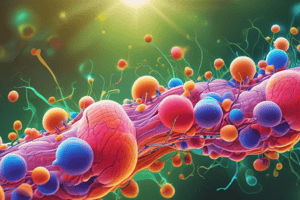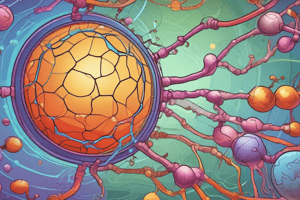Podcast
Questions and Answers
Which statement about energy and ATP is correct?
Which statement about energy and ATP is correct?
- ATP is transformed into energy.
- Energy is transformed directly from ATP.
- Energy is released when ATP is converted to ADP plus Pi. (correct)
- ATP is not involved in energy transfer.
In respiration, glucose is transformed into energy and ATP.
In respiration, glucose is transformed into energy and ATP.
False (B)
What do NADH and FADH2 do in cellular respiration?
What do NADH and FADH2 do in cellular respiration?
They serve as carriers of potential energy via their electrons.
What is the ultimate product of respiration?
What is the ultimate product of respiration?
What happens to the carbon atoms in glucose during respiration?
What happens to the carbon atoms in glucose during respiration?
Why is oxygen required for maximum energy use in glucose?
Why is oxygen required for maximum energy use in glucose?
What key role does oxygen play in cellular respiration?
What key role does oxygen play in cellular respiration?
Why do you weigh less after using glucose for energy during exercise?
Why do you weigh less after using glucose for energy during exercise?
What needs to be true of artificial sweeteners for weight loss?
What needs to be true of artificial sweeteners for weight loss?
What happens to protons moving back into the matrix through ATP synthase?
What happens to protons moving back into the matrix through ATP synthase?
What would happen if NADH transferred electrons directly to Complex II instead of Complex I?
What would happen if NADH transferred electrons directly to Complex II instead of Complex I?
What happens when the ETC is deprived of oxygen?
What happens when the ETC is deprived of oxygen?
What happens to the ETC when oxygen is withheld for longer?
What happens to the ETC when oxygen is withheld for longer?
What is the role of oxygen in the ETC?
What is the role of oxygen in the ETC?
Which of the following could be an effective treatment for severe cyanide poisoning?
Which of the following could be an effective treatment for severe cyanide poisoning?
What happens to cellular respiration if Q transfers electrons to Complex IV instead of Complex III?
What happens to cellular respiration if Q transfers electrons to Complex IV instead of Complex III?
What is consumed and produced during cellular respiration in yeast?
What is consumed and produced during cellular respiration in yeast?
What is produced by glycolysis, pyruvate processing, and the citric acid cycle for the electron transport chain?
What is produced by glycolysis, pyruvate processing, and the citric acid cycle for the electron transport chain?
Match the molecules with their role in the electron transport chain:
Match the molecules with their role in the electron transport chain:
Which molecule is reduced and which is oxidized in the reaction where Complex I transfers electrons to Q?
Which molecule is reduced and which is oxidized in the reaction where Complex I transfers electrons to Q?
Which of the following does NOT store potential energy that is usable by a cell?
Which of the following does NOT store potential energy that is usable by a cell?
Why do we lose mass while burning glucose during exercise?
Why do we lose mass while burning glucose during exercise?
Which of the following would decrease the number of ATP molecules generated per NADH in the electron transport chain?
Which of the following would decrease the number of ATP molecules generated per NADH in the electron transport chain?
What is the similarity between the effects of antimycin A and lack of oxygen?
What is the similarity between the effects of antimycin A and lack of oxygen?
For which of the following is potential energy INCREASING?
For which of the following is potential energy INCREASING?
What would happen metabolically if all your mitochondria were destroyed?
What would happen metabolically if all your mitochondria were destroyed?
Flashcards are hidden until you start studying
Study Notes
Energy and ATP
- Energy is released when ATP is converted into ADP and inorganic phosphate (Pi).
- Cells utilize the stored energy in glucose to synthesize ATP from ADP and phosphate.
NADH and FADH2
- NADH and FADH2 are electron carriers in cellular respiration, storing potential energy for ATP synthesis.
- They hold less energy than glucose but more than ATP itself.
Role of Oxygen
- Oxygen is crucial for maximizing energy extraction from glucose during respiration.
- It enables greater endurance (e.g., cyclists can go farther on less glucose).
Weight Loss and Glucose Utilization
- Weight loss occurs post-exercise as glucose is converted into carbon dioxide and water, which are lost through exhalation and sweat.
Artificial Sweeteners
- They mimic glucose's chemical structure, tricking our taste receptors.
- For effective weight loss, these sweeteners must not contribute to ATP synthesis, prompting the body to derive ATP from other food or stored fats.
ATP Synthesis and Proton Movement
- Protons move back into the mitochondrial matrix through ATP synthase, transferring their potential energy to ATP.
- If NADH bypasses Complex I in the electron transport chain (ETC), fewer protons would be pumped, resulting in reduced ATP production.
Effects of Oxygen Deprivation
- Initially, depriving the ETC of oxygen has minimal immediate effects.
- Prolonged oxygen deprivation leads the ETC to become unable to accept electrons from NADH and FADH2.
Complex Interactions
- In the ETC, oxygen plays a vital role by removing electrons from Complex IV, keeping the chain functional.
- If an individual has a mutation transferring electrons directly to Complex IV, NADH would still yield more ATP compared to FADH2.
Processes of Cellular Respiration
- Glycolysis, pyruvate processing, and the citric acid cycle produce NADH for use in the electron transport chain.
- Complex I oxidizes itself while reducing coenzyme Q (Q) during electron transfer.
Energy and Matter in Cellular Respiration
- Carbon dioxide does not store usable potential energy for cells.
- During glucose metabolism, mass is lost as glucose is converted to water and carbon dioxide, expelled from the body.
ATP Generation Efficiency
- Transferring electrons from NADH to Complex III instead of Complex I decreases ATP yield.
- Antimycin A's inhibition of electron transfer to Complex IV creates effects similar to oxygen deprivation.
Potential Energy Dynamics
- Potential energy in protons increases as they migrate from the mitochondrial matrix to the intermembrane space.
Mitochondrial Function
- Destruction of all mitochondria significantly reduces ATP availability, impairing bodily functions like movement and cognition.
Studying That Suits You
Use AI to generate personalized quizzes and flashcards to suit your learning preferences.




